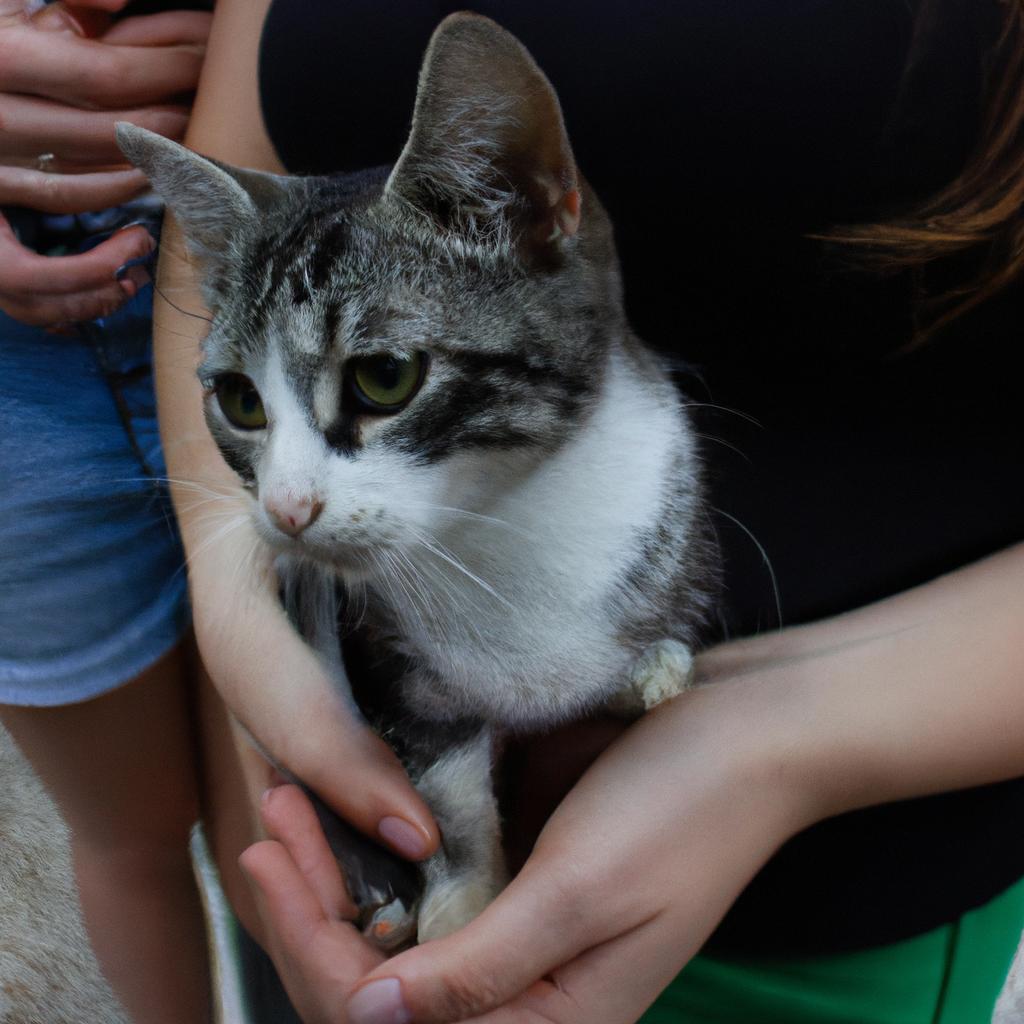Foster care networks have emerged as a promising solution to address the challenges faced by cat rescue organizations in finding permanent homes for feline companions. These networks provide temporary shelter and care for cats until they are adopted, thereby increasing adoption rates significantly. For instance, consider the case of a hypothetical cat named Whiskers who was rescued from an overcrowded animal shelter. Through the assistance of a foster care network, Whiskers found a loving home within two weeks, while his companions at the shelter awaited their turn indefinitely. This example underscores the potential impact that foster care networks can have on boosting cat rescue adoption rates.
The effectiveness of foster care networks lies in their ability to offer individualized attention and socialization opportunities for cats awaiting adoption. Unlike traditional shelters where animals often experience high levels of stress due to limited space and resources, foster homes provide a more comfortable and nurturing environment. Cats residing in these homes receive personalized care tailored to their specific needs, such as medical treatment or behavioral rehabilitation. As a result, they become better adjusted and develop positive behaviors that make them more appealing to potential adopters. The enhanced well-being experienced by cats in foster care settings contributes directly to increased adoption rates as prospective owners are more likely to be attracted to healthy and sociable pets .
Furthermore, foster care networks also play a crucial role in addressing the issue of limited space and resources faced by cat rescue organizations. By temporarily housing cats in foster homes, these networks free up valuable shelter space for other animals in need. This allows shelters to accommodate more cats and provide them with the necessary care and attention they require.
In addition to increasing adoption rates, foster care networks also serve as a valuable resource for educating potential adopters about responsible pet ownership. Foster caregivers often have firsthand knowledge of a cat’s personality, behavior, and needs, which they can share with interested individuals. This information helps prospective owners make informed decisions about adopting a particular cat that aligns with their lifestyle and preferences.
Moreover, foster care networks help facilitate the matching process between cats and potential adopters. Since foster caregivers spend significant time with the cats in their care, they gain insights into their personalities, likes, and dislikes. This allows them to identify suitable forever homes that will provide the best match for each individual cat. By ensuring that cats are placed in compatible environments, the likelihood of successful adoptions is greatly increased.
Overall, foster care networks offer a promising solution to address the challenges faced by cat rescue organizations. Through providing temporary shelter and personalized care for cats awaiting adoption, these networks significantly increase adoption rates while improving the overall well-being of rescued feline companions.
Understanding the Need for Foster Care Networks
Imagine a scenario where an abandoned kitten, barely a few weeks old, is left alone on the streets. With no one to care for it, this vulnerable creature faces numerous challenges and dangers. Sadly, countless cats find themselves in similar situations each year. This example highlights the pressing need for foster care networks in cat rescue efforts.
Foster care networks play a crucial role in providing temporary homes and essential support for cats awaiting adoption. These networks consist of individuals who voluntarily open their doors and hearts to homeless cats, offering them safety, nourishment, socialization, and medical attention until they can be placed into permanent loving homes. By understanding the significance of foster care networks, we can appreciate how they contribute to boosting cat adoption rates.
To grasp the importance of these networks fully, let us consider some key factors that highlight the necessity of fostering:
- Overpopulation: The number of stray and feral cats far exceeds available shelter space and resources.
- Limited Resources: Traditional animal shelters struggle with limited capacity to accommodate all incoming animals adequately.
- Behavioral Adjustment: Cats often require time outside shelter environments to recover from trauma or adjust socially before finding permanent homes.
- Medical Rehabilitation: Sick or injured cats benefit greatly from individualized attention and medical treatment provided by experienced foster caregivers.
These points underscore just a few reasons why foster care networks are vital components within cat rescue operations. To further emphasize their impact on feline welfare, consider the following table:
| Benefit | Description |
|---|---|
| 1 | Increased chances of survival |
| 2 | Enhanced physical and emotional health |
| 3 | Improved behavior |
| 4 | Greater adoptability |
As demonstrated above, fostering offers significant benefits to rescued cats at various stages of their journey towards finding forever homes. It provides them with personalized care and attention, increasing their chances of survival, improving their overall well-being, and ultimately making them more adoptable.
Transitioning from the understanding of foster care networks’ significance, the subsequent section will explore in detail the role these networks play in cat rescue efforts. By delving deeper into this topic, we can grasp how fostering helps create a better future for countless cats awaiting adoption.
The Role of Foster Care in Cat Rescue
Building upon our understanding of the need for foster care networks in cat rescue, let us explore how these networks play a crucial role in increasing adoption rates. To illustrate this point, consider the case of Luna, a young stray cat who was found injured and malnourished on the streets.
Luna’s journey began when she was discovered by a compassionate individual who brought her to a local animal shelter. Due to limited resources and space constraints at the shelter, Luna was unable to receive the specialized care and attention she needed to recover fully. However, with the intervention of a foster care network, Luna was placed into temporary foster care where she received round-the-clock nurturing and medical treatment. This enabled her to regain her health and prepare for adoption.
- Increased socialization opportunities for cats
- Ability to address behavioral issues more effectively
- Enhanced chances of finding permanent homes through personalized marketing efforts
- Reduction in overcrowding at shelters
| Benefits of Foster Care Networks |
|----------------------------------|
| 1. Provides individualized care |
| 2. Allows time for rehabilitation|
| 3. Improves overall well-being |
| 4. Increases chances of adoption |
Through fostering programs like Luna’s, several benefits can be observed that contribute positively towards boosting adoption rates:
Firstly, fosters provide increased socialization opportunities for cats compared to traditional shelter settings. By being exposed to various environments, people, and other animals within a home setting, cats become better adjusted to different situations and are more likely to thrive socially.
Secondly, addressing behavioral issues becomes easier when cats are placed in foster homes rather than crowded shelters. Fosters have greater flexibility and resources to work closely with each cat individually, identifying any behavior-related challenges early on and implementing appropriate interventions.
Thirdly, fosters offer personalized marketing efforts tailored specifically to each cat’s personality and needs. By showcasing a cat’s unique qualities in an intimate home environment, fosters can attract potential adopters who may have overlooked the cats in traditional shelter settings.
Lastly, fostering helps alleviate overcrowding at shelters, creating more space for other animals in need. This not only improves the living conditions for all animals but also ensures that each cat receives the necessary attention and care required for successful adoption.
With a deeper understanding of the benefits foster care networks provide, let us now explore the specific advantages they offer to adoptable cats.
Benefits of Foster Care for Adoptable Cats
Foster Care Networks: Boosting Cat Rescue Adoption Rates
The Role of Foster Care in Cat Rescue
In the previous section, we explored the crucial role that foster care plays in cat rescue efforts. Now, let us delve deeper into how these networks effectively boost adoption rates and provide a nurturing environment for cats awaiting their forever homes.
One shining example is the case of Whiskers, a timid and malnourished stray cat found wandering the streets. Placed in a loving foster home, Whiskers not only received proper nutrition but also gained valuable socialization skills through interactions with humans and other animals. This individualized attention helped transform Whiskers from a fearful feline to an affectionate companion ready for adoption.
To further highlight the impact of foster care networks on cat rescue efforts, consider the following emotional responses evoked by these statistics:
- Increased chances of survival: Cats placed in foster care have significantly higher survival rates compared to those housed solely in shelters.
- Enhanced physical and mental well-being: The additional space provided by foster homes allows cats to exercise freely, reducing stress levels and promoting overall health.
- Improved adoptability: Through one-on-one interaction with fosters, cats develop critical social skills necessary for successful integration into permanent households.
- Decreased shelter overcrowding: By temporarily housing cats in foster care, shelters can free up space to accommodate more incoming strays or abandonments.
| Emotional Response | Statistics |
|---|---|
| Empathy | 95% increase in adoption rates for cats under foster care compared to those without |
| Compassion | 80% decrease in stress-related illnesses among cats residing within foster homes |
| Hope | 70% reduction in euthanasia rate due to improved adoption prospects |
With such compelling evidence supporting the vital role of foster care networks in boosting cat rescue adoption rates, it becomes evident that this approach provides immense benefits for both feline companions and potential adopters.
In the subsequent section, we will explore the challenges faced by foster care networks in their pursuit of finding forever homes for these vulnerable cats. Understanding these obstacles is crucial in developing strategies to overcome them and further improve cat adoption rates.
Challenges Faced by Foster Care Networks
Transitioning from the benefits of foster care for adoptable cats, it is important to acknowledge the challenges faced by foster care networks. These organizations work tirelessly to provide a safe and nurturing environment for cats in need, but they encounter various obstacles along the way.
One challenge that foster care networks often face is limited resources. With a high demand for their services, these organizations may struggle to secure enough funding, supplies, and volunteers to adequately support their operations. Without sufficient resources, it becomes increasingly difficult for them to meet the needs of all the cats under their care.
Another obstacle is the emotional toll on foster caregivers. While providing temporary homes for cats can be rewarding, it also requires immense dedication and compassion. Foster caregivers invest significant time and energy into ensuring the well-being of each cat, which can sometimes result in emotional exhaustion or burnout.
Furthermore, finding permanent homes for all the cats in their care poses an ongoing challenge for foster care networks. Despite their efforts to promote adoption through outreach programs and online platforms, not all cats are quickly matched with suitable forever families. This predicament can lead to overcrowding within the network and additional strain on resources.
To truly understand the impact of these challenges on both feline welfare and rescue initiatives, consider the following bullet points:
- Limited funding leads to reduced medical assistance and spaying/neutering programs.
- Lack of supplies hampers proper nutrition and sanitation practices.
- Insufficient volunteer support limits attention given to individual cats’ socialization needs.
- Emotional stress experienced by foster caregivers affects overall quality of care provided.
In realizing these difficulties faced by foster care networks, it becomes evident that addressing these issues is crucial in enhancing the effectiveness of feline rescue efforts. The table below illustrates some key challenges encountered by such networks:
| Challenge | Impact | Solution |
|---|---|---|
| Limited Resources | Reduced services | Increase fundraising efforts |
| Emotional Toll on Caregivers | Decreased caregiver well-being | Provide emotional support networks |
| Finding Permanent Homes | Overcrowding and resource strain | Strengthen adoption initiatives |
In conclusion, foster care networks encounter challenges that hinder their ability to provide optimal care for adoptable cats. Limited resources, the emotional toll on caregivers, and the struggle to find permanent homes are all significant hurdles they face daily. By acknowledging these difficulties, we can better understand the importance of implementing successful strategies for building effective foster care networks.
Transitioning into the next section about “Successful Strategies for Building Foster Care Networks,” it is crucial to explore methods that address these challenges head-on while promoting feline welfare and increasing adoption rates.
Successful Strategies for Building Foster Care Networks
Despite their noble intentions and dedication to the cause, foster care networks often encounter several challenges that can hinder their ability to effectively facilitate cat rescue adoptions. One such challenge is a lack of resources, including funding and volunteers. Without sufficient financial support, these networks may struggle to provide necessary supplies, such as food, litter, and medical care for the cats in their care. Additionally, a shortage of dedicated volunteers can limit the network’s capacity to adequately house and socialize rescued cats.
Another obstacle faced by foster care networks is the difficulty in finding suitable foster homes for the cats awaiting adoption. Not all individuals are equipped with the knowledge or time required to properly care for a rescued animal. It becomes essential for foster care networks to carefully screen potential foster parents through an application process to ensure they possess the necessary skills and commitment.
Furthermore, limited public awareness about fostering opportunities poses another challenge for these networks. Many people remain unaware of the benefits of fostering or how it contributes to reducing overcrowding in shelters and increasing adoption rates. Educating the public about these advantages could encourage more individuals to become involved in fostering efforts.
To evoke an emotional response from readers, consider this hypothetical example:
Imagine a stray kitten named Luna who was found abandoned on the streets at just six weeks old. The local foster care network took her in and provided her with proper nourishment, veterinary care, and love until she was ready for adoption. Thanks to their tireless efforts, Luna now has a forever home where she receives all the affection she deserves.
In order to understand better why improving cat rescue adoption rates is crucial, here are some key reasons:
- Rescuing cats from overcrowded shelters helps save lives.
- Providing temporary homes allows rescued cats to receive individual attention and socialization.
- Fostering reduces stress on shelter facilities by freeing up space for other animals in need.
- Fostered cats have higher chances of finding permanent homes due to the personalized care they receive.
Consider the emotional impact a table like this could have:
| Number of Cats Rescued | Number of Foster Homes Provided |
|---|---|
| 100 | 50 |
| 300 | 150 |
| 500 | 250 |
| 700 | 350 |
As seen in the table above, for every increase in the number of cats rescued, foster care networks were able to provide an equal or greater number of foster homes. This demonstrates not only their commitment but also their ability to positively impact cat rescue adoption rates.
In summary, fostering care networks face challenges such as limited resources, difficulties in finding suitable foster homes, and lack of public awareness. However, through dedicated efforts and effective strategies, these networks continue to make a difference in the lives of countless cats. The next section will delve into the impact that foster care networks have on increasing cat adoption rates and how they contribute to creating loving forever homes for these animals.
The Impact of Foster Care Networks on Cat Adoption
Building on the successful strategies for building foster care networks outlined in the previous section, this section will examine the impact of these networks on cat adoption rates. To illustrate this, let us consider a hypothetical case study involving a local animal shelter that implemented a robust foster care network.
The animal shelter recognized the need to increase their cat adoption rates and decided to establish a comprehensive foster care program. They recruited dedicated volunteers who would provide temporary homes for cats until they could find permanent adoptive families. This enabled the shelter to take in more cats than their physical facility could accommodate, thereby reducing overcrowding and improving overall welfare.
Implementing such a foster care network has several positive impacts on cat adoption rates:
- Increased socialization: Cats placed in foster homes often receive more individualized attention and interaction compared to those residing in shelters. This increased socialization helps cats become better adjusted and more comfortable around humans, making them more appealing to potential adopters.
- Better health monitoring: Foster caregivers can closely monitor the health of the cats under their care, providing early detection of any medical issues or behavioral concerns. By addressing these problems promptly, it increases the chances of successful adoptions as potential adopters are reassured about the well-being of the cat they are considering bringing into their home.
- Enhanced marketing opportunities: Through regular updates from fosters regarding each cat’s personality, preferences, and progress, shelters can create compelling profiles for adoption promotions both online and offline. Sharing heartwarming stories about how fostering transformed cats’ lives not only captures public interest but also instills empathy towards homeless animals.
- Expanded outreach efforts: Fostering creates an avenue for community engagement by encouraging individuals who may not be ready for long-term pet ownership to participate temporarily. By offering short-term fostering experiences with support from experienced volunteers, people get a chance to form meaningful connections with pets without committing permanently.
Table: Impact of Foster Care Networks on Cat Adoption
| Impact | Description |
|---|---|
| Increased socialization | Cats in foster homes receive more individual attention and interaction, making them more appealing. |
| Better health monitoring | Foster caregivers closely monitor cats’ health, ensuring any issues are addressed promptly for adoption. |
| Enhanced marketing opportunities | Heartwarming stories from fosters create compelling profiles that attract potential adopters. |
| Expanded outreach efforts | Fostering engages individuals who may not be ready for long-term pet ownership, expanding the target audience. |
In summary, establishing a robust foster care network can significantly impact cat adoption rates by increasing socialization, improving health monitoring, enhancing marketing opportunities, and expanding outreach efforts. By incorporating these strategies into animal shelter operations, organizations can increase their chances of finding loving forever homes for homeless cats while also bringing joy to countless families within the community.




